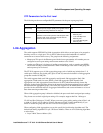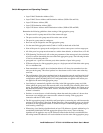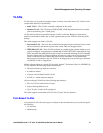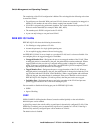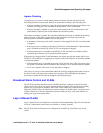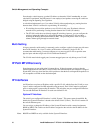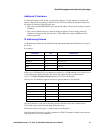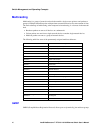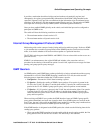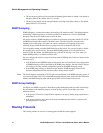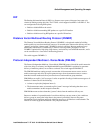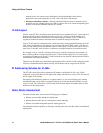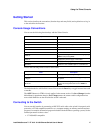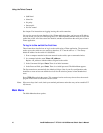Intel® NetStructure™ ZT 8101 10/100 Ethernet Switch User’s Manual 41
Switch Management and Operating Concepts
It provides a mechanism that allows bridges and end-stations to dynamically register (and
subsequently, de-register) group membership information with the MAC bridge attached to the
same LAN segment. It also provides a mechanism for that information to be disseminated across
all bridges in the bridged LANs that support extended filtering services. The operation of GMRP
relies upon the services provided by GARP (Generic Attribute Registration Protocol).
Once you have enabled GMRP globally on the switch, each individual port can be configured to
participate in GMRP or not.
The switch will have the following restrictions on members:
• The maximum number of static entries is 32.
• The maximum number of dynamic entries is 64.
Internet Group Management Protocol (IGMP)
Multicasting relies on the concept of nodes joining and leaving multicast groups. Nodes use IGMP
to join and then leave a multicast group. Based on the IGMP reports the switch receives from the
nodes, it can decide whether to forward a multicast packet on a particular interface.
The ZT 8101 switch supports both IGMPv1 and IGMPv2. You can select which version to use on a
particular VLAN.
IGMPv2 is an enhancement to the original IGMP and includes a few extensions such as a
procedure for the election of the multicast querier for each LAN, explicit leave messages for faster
pruning, and group-specific query messages.
IGMP Queriers
An IGMP querier sends IGMP Query packets periodically to help to maintain the multicast group
information for a VLAN. When IGMP Snooping is enabled for a VLAN, the switch uses the
following states to determine whether the VLAN becomes a querier:
• Non-Querier—Prevents the VLAN from becoming a querier.
• V1 Querier—Enables the sending of IGMPv1 query packets. If no querier is present in the
VLAN or the VLAN’s IP address is smaller than current V1 querier, the switch becomes the
querier for the VLAN. IGMPv2 group-specific query and leave packets are not handled.
• V2 Querier—If a V1 querier is present in the VLAN, the switch remains silent. If no querier
is present in the VLAN or the VLAN’s IP address is smaller than current V2 querier, the
switch becomes the querier for the VLAN. The switch then handles IGMPv2 group-specific
query and leave packets.
When receiving an IGMPv2 leave packet, the IGMP interface issues an IGMPv2 group specific
query packet immediately and waits one second to check if any IGMP reports are received on the
ports. If not, the port is removed from the IGMP group member list, and the group's multicast data
is not forwarded to this port until an IGMP report is received again.
If the IGMP interface is designated as the IGMP querier, the switch uses the following intervals for
sending query packets:
• When you enable IGMP snooping or boot the switch with the querier option enabled, the first
query packet will not be sent for 255 seconds. This time delay is non-standard.



